Product Development in the Point Cloud
The new generation of product design begins with point clouds from scans of physical objects
Latest News
May 20, 2010
By Ping Fu
A lot has been written about cloud computing—working with data and applications over the Internet—but an equally powerful movement might be the one centered on another cloud: the point cloud.
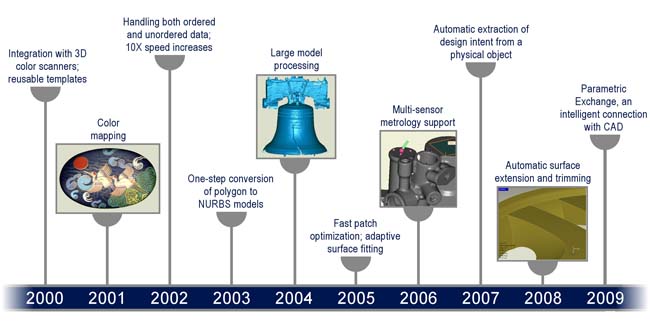 The evolution of 3D point-processing software. (Courtesy of Geomagic) |
For more than a decade, engineers have been able to scan physical objects and create a 3D point cloud. A point cloud is exactly what the name suggests: a digital collection of points that represent a physical object.
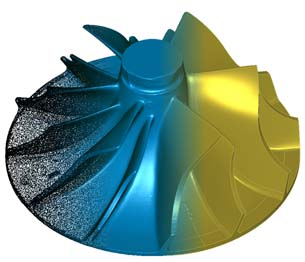 The phases of the process in which a point cloud is converted into a 3D parametric CAD model. (Courtesy of Geomagic) |
In the past, it’s taken a fair amount of expertise to go from a point cloud to an accurate 3D model that can be edited in a CAD program. But steady progress over the last 10 years, aided by two recent breakthroughs, has created a data freeway originating from the point cloud.
Points of Origin
In industries spanning automotive, aerospace, consumer products, and medical devices, product development and analysis starts at the point cloud. From there, it branches into a wide range of potential applications, including mechanical and freeform design, mass customization, computer-aided engineering analysis, inspection and quality control, and rapid prototyping.
Point-cloud processing closes the loop between the physical and digital worlds, providing the physical-digital match that cannot be obtained with an idealized CAD model. Think of it as the 3D equivalent of what Adobe offers for the 2D document world.
Until recently, the most tenuous part of the physical-digital loop was making the connection between 3D scan data and 3D CAD parametric models. Over the past two years, that connection has been simplified and streamlined by two major developments. One is the ability to capture and reproduce design intent for a physical object; the other is Parametric Exchange, which enables automatic native reconstruction of geometry, speeding product development time, and increasing quality of the final model.
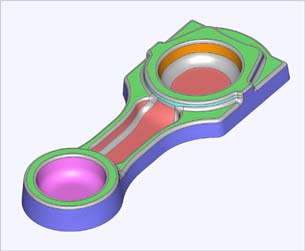 New point-processing technology extracts design intent from scanned physical objects. In this image, surfaces are classified according to basic shapes such as planes, cylinder and freeform. (Courtesy of Geomagic) |
Closing the Physical-Digital Loop
Two years ago, a major step was made in closing the physical-digital loop. It’s called “design-intent modeling” – the ability to automatically extract design intent from a physical object.
Design-intent modeling extends reverse engineering from simply producing an accurate digital copy to extracting the original design intent from a scan of a physical model, kick-starting the process of modeling and adapting that design in CAD. Users can start with physical models and prototypes of a new design (such as a car body sculpted in clay) and quickly get to a digital, CAD-ready representation.
The ability to generate CAD-ready surfaces from scans of physical objects laid the groundwork for another significant development – Parametric Exchange.
The Intelligent Connection
Parametric Exchange completes the software bridge between point clouds and CAD. It provides an intelligent connection with CAD to enable automatic native reconstruction of geometry. With Parametric Exchange, parametric surfaces, datums and curves can be transferred from point-processing software to CAD without the need for intermediate neutral files such as IGES or STEP.
The Parametric Exchange process leverages the specific strengths of point processing and CAD software. Point-processing software organizes and processes point-cloud data to create CAD models, and CAD software enables users to further modify and prepare models for product design and manufacturing.
Freedom to Explore and Customize
The closed loop between scan data and CAD gives industrial designers the freedom to explore new and endless variations of products. Think of thousands of permutations of classic Nike shoes, individualized Mattel toys, or personalized gas tanks for Harley-Davidson motorcycles.
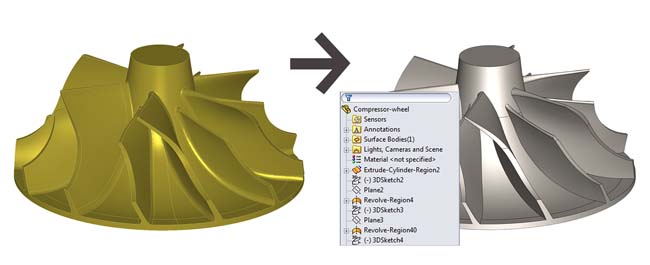 Parametric Exchange provides an intelligent connection with CAD to enable automatic native reconstruction of geometry, speeding product development time and increasing quality of the final model. (Courtesy of Geomagic) |
It also has the potential to save manufacturers millions in tooling costs. Instead of recreating an expensive mold from scratch, for example, companies can scan an existing one, analyze the wear and tear, design an improved model, and manufacture new molds in days instead of weeks or months.
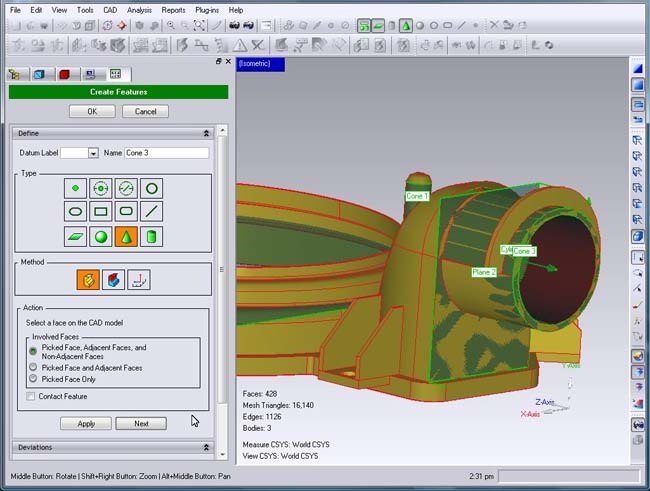 Schneider Electric has used the latest generation of point-cloud processing software to progress from dimensional analysis of singular parts to analyzing functionality for entire assemblies. (Courtesy of Schneider Electric) |
The ability to capture an existing design and quickly adapt it to new styles and purposes is critical to the evolution from mass manufacturing to mass customization. The combination of design-intent modeling with parametric modeling provides many of the essential tools that will deliver on the promise of individualized design on an affordable, mass scale.
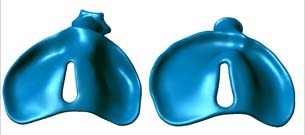 An engineer-physician team at Shriners Hospital for Children uses point-cloud processing software for non-invasive treatment of babies’ cleft lip and palate. These are the first and last appliances in the series used for treatment. (Courtesy of Shriners Hospital for Children). |
Better Quality, Realistic Analysis
Streamlined processing of point clouds into accurate digital models is also opening up new applications in 3D inspection, computer-aided analysis, and quality control. Companies now have the ability to almost instantly scan a product coming off an assembly line and compare it to the idealized CAD model to determine deviations and changes caused by tooling or molds.
Car companies can conduct finite-element analysis (FEA) and computational fluid dynamics (CFD) simulations based on the actual digital model of an as-built part or assembly, rather than the less-realistic CAD model. Maintenance, repair and overhaul (MRO) organizations can quickly assess damage to parts and fulfill the dual goals of better repairs and getting planes back in the air faster. And in organizations such as Schneider-Electric and ITT/Goulds Pumps, point-cloud processing is driving major engineering changes.
Schneider-Electric has progressed from dimensional analysis of singular parts to being able to analyze functionality for an entire assembly, saving countless hours and material across the company’s 90,000-employee, 130-country operations.
At ITT/Goulds Pumps, point-cloud processing has generated quality control breakthroughs, including new processes to improve impeller balance and determine foundry process variation. The time it takes to analyze impeller balance has been reduced from hours to 10 minutes, and the ability to accurately measure wall thickness for molds is delivering greater quality in much less time.
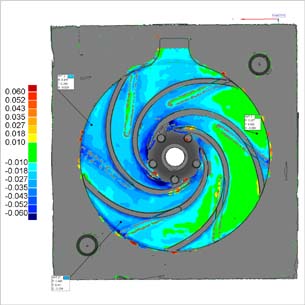 Point-cloud processing software generates a 3D comparison showing deviation between a sand mold casting and the resulting part. ITT/Goulds Pumps calls this the “eureka moment” that reduces analysis time from hours to minutes. (Courtesy of ITT/Goulds Pumps) |
New Medical Insight
Industrial processes based on point clouds have crossed the chasm into medical, where the ability to scan a body part or a dental mold enables doctors and dentists to tailor treatments to the exact physiological needs of their patients. The results include better fit and functionality of prosthetic, dental and hearing devices; less invasive and more personalized treatment; greater ability to analyze success of treatment and make adjustments; and better communication with patients through 3D imaging.
From points to endless possibilities
The beauty of applications spawned from the point cloud is their seemingly infinite variety. A confluence of ideas and new applications are coming out of dialogue among industrial, medical and artistic communities.
At Convergence 2009, the Geomagic user conference, presentations covered everything from refining 119-year-old foundry processes to exposing a fraudulent Picasso sculpture; from the quest to set a world land speed record to innovations in dental implants; from new applications in pediatric orthopedics to major reductions in industrial time-to-market and return-to-market cycles.
Within automotive and aerospace companies, hospitals, consumer product manufacturers, design boutiques, electrical component makers, medical device providers and a host of traditional and newly minted entities popping up throughout the world, a quiet revolution is taking place. And, it all starts with the point cloud.
Ping Fu is president and CEO of Geomagic, a leading provider of 3D software for creating digital models of physical objects.
Subscribe to our FREE magazine, FREE email newsletters or both!
Latest News
About the Author
DE’s editors contribute news and new product announcements to Digital Engineering.
Press releases may be sent to them via [email protected].






